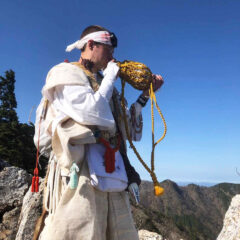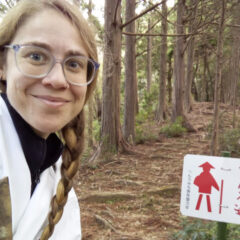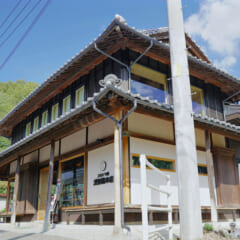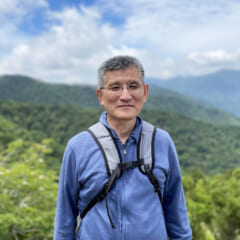My Shikoku Journey (15) by Don, USA

![]() Don Weiss,USA
Don Weiss,USA ![]() Complete Shikoku Pilgrimage
Complete Shikoku Pilgrimage
Travel Light! Really light!! Lighter than that!!!
Anyone can do the Shikoku Pilgrimage with a pack weighing under 5 kg, plus whatever snacks and drinks they want for the day. Many days you don’t need to carry any snacks or drinks – you can buy them along the way.
In this article, I’ll explain WHY you should go light, HOW you can, WHAT I carry, and what you think you need but DON’T.
WHY you should travel light
The Shikoku Pilgrimage is longer, harder, and less well-organized than other similar pilgrimage routes. It is 1137.3 km if you don’t take any detours and you never get lost. Since you will do both (trust me), assume you will travel 1200 km or more. Also, there are thousands of meters up and down. * If you walk the whole route, it will take 6-8 weeks.
*Details here: http://shikokuhenrotrail.com/shikoku/pilgrimagemap.html
Some trails have luggage delivery service. The Shikoku Pilgrimage does not. The famous ”Takkyubin”(Japanese package delivery companies) don’t have same-day service on Shikoku. You can hire a taxi to take your bag from one inn to the next, but will cost a few thousand yen each time.
Another reason you should carry everything you need with you is because, at some point during your pilgrimage, you may not make it to your planned destination due to weather, illness, injury, mental stress, or some other problem. If you have sent your bag ahead, you will be without a change of clothes. (If this happens, you MUST call your reserved lodging and let them know you won’t be staying there.)
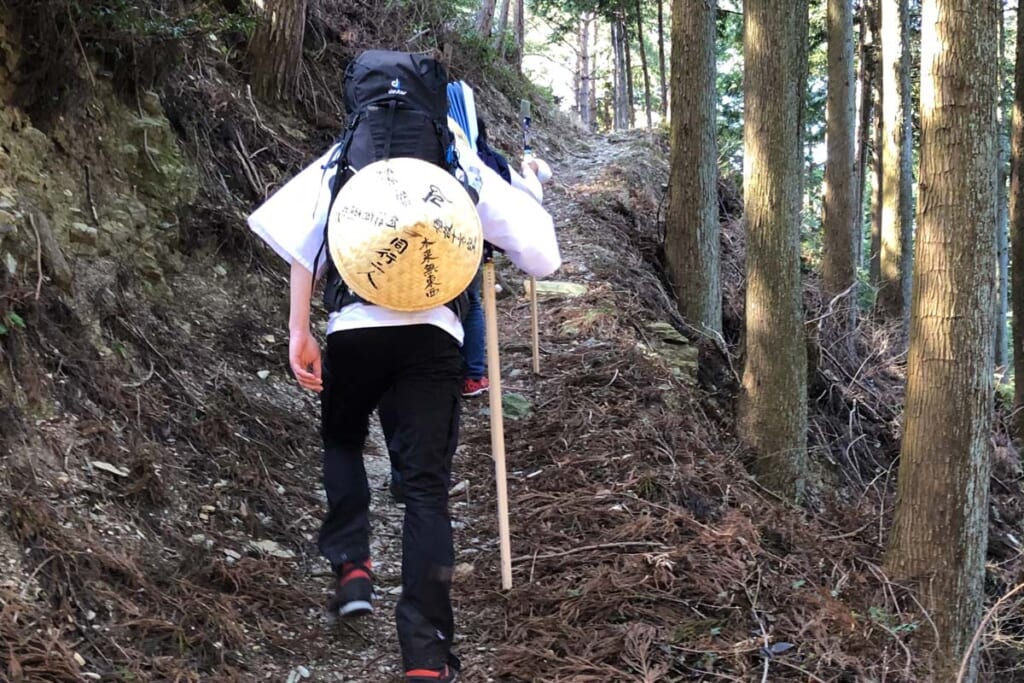
HOW to travel light
Traveling light is a Japanese tradition. When you see Japanese pilgrims, you may notice that their packs are smaller than the packs of most foreign pilgrims. They understand the system.
The lodgings along the pilgrimage route have yukata that you can sleep in. Most Japanese will wear the yukata to dinner in the inn. You can also wear the yukata while your clothes are being washed and dried in the coin-operated washers and dryers that nearly all the inns provide. (Some are free for pilgrims – others cost 100-200 yen for the washer plus 100-200 for the dryer. A few only have washing machines.) All inns have hair dryers, soap, shampoo, small towels, and body wash.
In addition, you will pass stores every day. You can replace your used-up toothpaste, sunscreen, insect repellant, etc. at any convenience store or supermarket. (Convenience stores also stock underwear, caps, gloves, and catalytic heat packets.) If you need something more, the towns have stores with shoes, pants, rain-gear, etc. You can buy a cheap umbrella (300 yen), use it for one day, and leave it at your inn for the next pilgrim.
If worse comes to worst, you can order almost anything from Amazon Japan and have it delivered to an inn one or two days ahead (call and ask the inn). (Exception: People like me with very large feet can only buy shoes and socks at a few places in Japan. Amazon.jp has a very limited selection of large-size, high-quality trail runners and hiking shoes.)
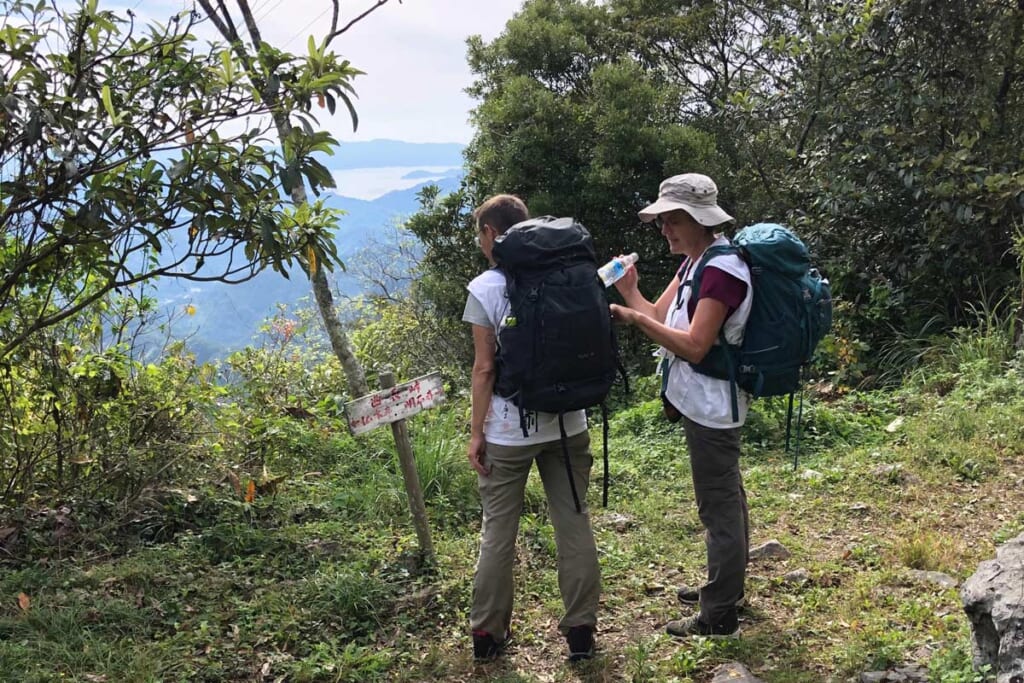
WHAT I CARRY (and how much it weighs – very personal list)
PACK: maximum weight not including food and drink – 4301 g.
I say maximum weight because sometimes I wear some of these things like the Gore-Tex jacket and rain pants. This includes the weight of the pack but doesn’t include one set of clothes since I always wear that.
VEST: I also carry some things in a many-pocketed vest, so the total amount I carry is more than 4303 g. The weight of the vest is part of my total weight, but so is the weight of the clothes I wear and the weight I put on last year from eating too many cookies.
Clothing
I wash clothes every other day – it keeps my pack light.
| 330 g | 2 tee-shirts |
| 201 g | lightweight knit top |
| 70 g | undershorts |
| 325 g | puffy (very light down jacket) in stuff sack |
| 59 g | knit cap in cool weather, baseball-type cap in warm weather |
| 118 g | socks (I wear Smartwool socks from REI) |
| 301 g | rain pants (I wear them or a yukata at the inn when I wash my hiking pants) |
| 317 g | Gore-Tex jacket |
| 33 g | gloves in cool weather |
| 50 g | two bandanas (they have so many uses) |
| 30 g | net bag for laundry (I often share a washing machine with others) |
| 1834 g | TOTAL for clothes |
Henro goods (in a big ziplock bag)
I don’t carry candles or incense.
| 479 g | nokyocho (stamp book) |
| 98 g | name slips (100 name slips and two pens) |
| 577 g | TOTAL for Henro goods |
Electronics
My phone, charging cable, plug, and extra battery are always in the pockets of my vest.
Sometimes I carry an iPad and other electronic items, but of course these aren’t necessary.
Medical, toiletries, repairs
| 42 g | towel (The inns always have towels, but I carry this anyway. Don’t forget your towel!) |
| 120 g | tooth care, nail clippers, etc. |
| 31 g | bandaids and alcohol wipes |
| 90 g | repair kit (needle and thread, strong tape, etc.) |
| 283 g | TOTAL for Medical, etc. |
Other
I carry a lightweight cotton shoulder bag/tote bag (75 g) that I use for shopping and when I am leaving my pack behind for a day hike up a mountain, etc. This is enough because I always wear a many-pocketed vest – an important part of my pilgrimage gear.
My backpack is an Osprey Exos 48 large men’s pack. I remove the “brain” from the pack. The pack weighs 1179 g. I carry at least two large plastic bags so everything in the pack stays dry even in an all-day rain. This pack is much bigger than necessary for what I carry. I use it because it is tall enough that I can keep 100% of the weight on the waist-belt – no weight at all on my shoulders. You can put a finger under the shoulder straps when I wear this pack. Most people use a pack of around 35 liters.
| 140 g | two lightweight water bottles (sometimes empty, sometimes full) |
| 1179 g | pack |
| 148 g | pack cover |
| 75 g | cotton shoulder bag/tote bag |
| 1542 g | TOTAL for Other |
Sleep system for camping
I don’t normally carry this.
| 474 g | bivy sack |
| 535 g | down quilt |
| 68 g | inflatable pillow |
| 443 g | Thermarest Pro Plus mattress in stuff sack |
| 84 g | underpad for the bivy |
| 1604 g | TOTAL for Sleep system for camping |
Conclusion
My pack, fully loaded, not counting food, drink, and some things in my vest, normally weighs a little over 4 kg plus whatever snacks and drinks I am carrying for the day. You can do this too. Go light. Go lighter! It will make your pilgrimage simpler, less painful, and more rewarding.
EXTRA things to consider
DO NOT take all of these! You can buy just about anything in stores along the way or online.
- Bring any prescription medicines you need with the prescriptions. Some prescription drugs you have may not be allowed in Japan – check! Some over-the-counter drugs you have may be prescription-only in Japan – check!
- If you are prone to blisters, you might bring something to treat them. You can, of course, buy all of that in any pharmacy in Japan, but you might want it sometime when you are not right in front of a pharmacy. I carry a small roll of tape (sold in Japan as “taping tape”) for other people if they have a hot spot that might turn into a blister. I haven’t needed it myself for about four years, since I started wearing Altra trail-runners with Smartwool socks. (Altras are great for most people, but not everybody.) I think everyone should carry a small roll of tape just in case. (I said SMALL. You can buy more.)
- The pillows at Japanese inns are usually VERY hard. You might want to bring an inflatable pillow. I just put some clothes in the stuff sack for my puffy.
- Most Japanese inns give you a futon on a tatami floor. There are usually extra futons in a cupboard in the room. Of course, you can always ask for extra pillows and futons. If you need a softer bed, you might bring a lightweight inflatable mattress. I sometimes do. This is probably more important for side-sleepers like me.
- If you bring souvenirs to give to people you meet, they should weigh little or nothing. But really, this isn’t necessary. The pilgrimage tradition is to give people one of your name slips (filled out) as a thank-you.
A few more notes about traveling light
Souvenirs
If you buy souvenirs, unless they weigh almost nothing, send them home immediately. It may be possible to send them back to the hotel where you left your city clothes, but only if you arranged this ahead of time. (I don’t recommend it.)
You can mail things to your home anywhere in the world from any Japanese post office. They also have boxes and mailing bags. Some tourist shops will send souvenirs directly to your home.
Leave your city clothes behind
Several hotels and inns in Tokushima City and near Ryōzenji will store one bag for you if you stay there at least one night before and after the pilgrimage. (Many people also spend one or two nights in Tokushima City between Idoji and Onzanji (temples 17 and 18).
Ask when making reservations. Hostel PAQ has a large storage room. Other hotels may or may not have room for your bag.
Things you think you might need to bring that you probably don’t
- A pair of pants to change into in the evening
At the inn, you can wear the yukata they provide or your hiking pants (or hiking shorts in warm weather). If you go out to dinner, wear your hiking pants/shorts. You’re a pilgrim, not a tourist. How often do you need to wash your hiking pants – once a week? Wear the yukata.
- Extra shoes
Most people get through the pilgrimage with one pair of shoes. Start off with a new pair of a kind you have used before. There are shoe stores in every town, outdoor clothing/equipment stores here and there, plus Amazon Japan. You really don’t need to carry a second pair. (Possible exception, as I said before, people with very large feet.)
- Camping gear
If you plan to camp, bring it, but don’t bring it just in case. There are always options. You may have to take a bus or taxi sometime, or take one very long day or very short day, but doing that once or twice is better than carrying full camping gear for 6 – 8 weeks and only using it once or twice – or not at all.



